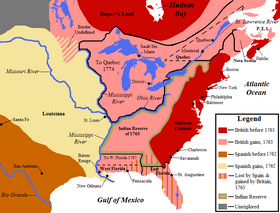
Territorial changes from the Treaty of Paris.
The Royal Proclamation of 1763 was a proclamation issued by King George III of Great Britain on 7 October 1763, eight months after the signing of the Treaty of Paris ending the Seven Years' War, and five months after the outbreak of Pontiac's War. The Proclamation dealt with the management of inherited French colonies from the Treaty, as well as regulating colonial expansion. It established new governments for four areas: the province of Quebec, the new colonies of West and East Florida, and the Caribbean island of Grenada.
In order to regulate colonial expansion, the Proclamation established a boundary along the Appalachian watershed between the colonial lands of the Atlantic seaboard and the Indian lands of the Mississippi basin. The Proclamation also banned the private purchase of Indian land; henceforth, all land purchases from the Indians would be made by Crown officials "at some public Meeting or Assembly of the said Indians". Furthermore, British colonists were forbidden to move beyond the line and settle on native lands, and colonial officials were forbidden to grant grounds or lands without royal approval. The proclamation gave the Crown a monopoly on all future land purchases from American Indians.
Almost immediately, many British colonists and land speculators objected to the proclamation boundary, since there were already many settlements beyond the line, as well as many existing land claims yet to be settled. The American colonists' resentment against the Proclamation was the first rift in the growing American Crisis.
